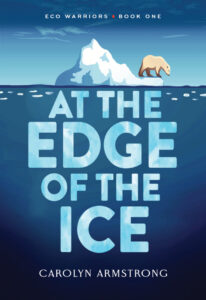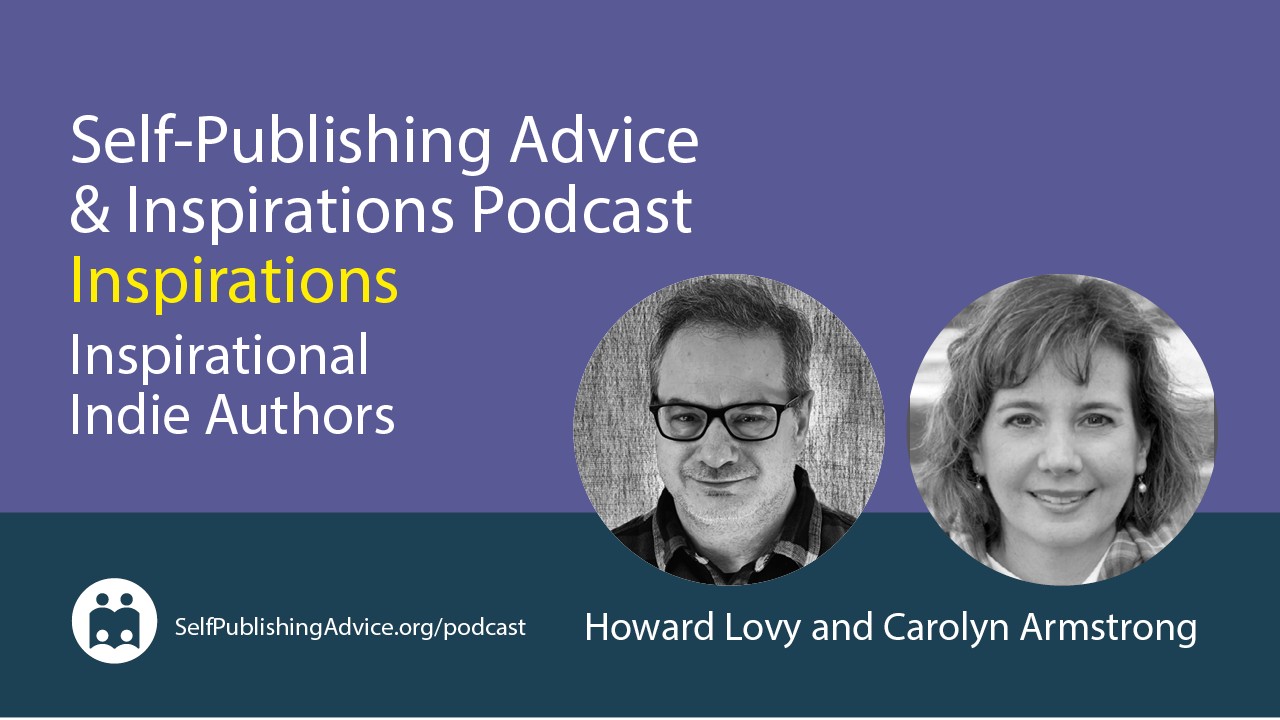My ALLi author guest this episode is Carolyn Armstrong, who enjoys writing books about and for middle-grade kids, because they're just beginning to seek independence while still relying on adults. Carolyn writes earth-friendly fiction and discovered that teachers and parents find her books valuable as educational tools. And some of them discover her books via Pinterest.
Find more author advice, tips, and tools at our Self-publishing Author Advice Center, with a huge archive of 2,000+ blog posts, and a handy search box to find key info on the topic you need.
We invite you to join our organization and become a self-publishing ally, if you haven’t already. You can do that at allianceindependentauthors.org.
Listen to the Inspirational Indie Author Interview: Carolyn Armstrong
On the Inspirational Indie Authors #Podcast, @howard_lovy features Carolyn Armstrong, an earth-friendly middle-grade fiction author who finds her readers through teachers, parents, and Pinterest. Share on XDon't Miss an #AskALLi Broadcast
Subscribe to our Ask ALLi podcast on iTunes, Stitcher, Player.FM, Overcast, Pocket Casts, Spotify or via our RSS feed:
Inspirational Indie Author Interview: Carolyn Armstrong. About the Author

Carolyn Armstrong is the author of Earth-friendly middle grade fiction. A former educator and now an imperfect environmentalist, she blends her love of travel and animal well-being into her stories. She encourages everyone to become advocates for Planet Earth. It’s as easy as picking up trash and refusing a plastic drinking straw! Head to her website for free activities, monthly newsletters, and blogs about writing, books, and sustainability. Carolyn can also be found on Instagram and Pinterest.
About the Host
Howard Lovy has been a journalist for more than 35 years, and now amplifies the voices of independent author-publishers and works with authors as a developmental editor. Find Howard at howardlovy.com, LinkedIn and Twitter.
If you’re a published indie author who would like to be interviewed by Howard for the Inspirational Indie Authors podcast, you need to be a member of the Alliance of Independent Authors.
Then contact Howard, including your membership number, explaining why you’re an inspirational indie author and what inspires you.
If you haven’t already, we invite you to join our organization.
Read the Transcripts to the Inspirational Indie Author Interview: Carolyn Armstrong
Howard Lovy: My guest this episode is Carolyn Armstrong, who enjoys writing books about and for middle-grade kids because they're just beginning to seek independence while still relying on adults.
Carolyn writes earth-friendly fiction and discovered that teachers and parents find her books valuable as educational tools, and some of them discover her books via Pinterest. I'll let Carolyn Armstrong tell her story.
Carolyn Armstrong: My name is Carolyn Armstrong. I am the author of middle-grade earth-friendly fiction.
I have two books. One is traditionally published, called Because of Khalid, and this new series, Eco Warrior series, the first book is At the Edge of the Ice, is independently published by myself, and it is the first book in a series of three that focuses on climate change.
I grew up not far from where I'm currently living in another suburb, north of Chicago.
I was actually in the remedial reading class in my junior year, or junior high. I can't believe it when I say that, but the option was in my school, in middle-grade, you could either in 8th grade take Latin, or you could go into this, I call it the loser reading group, and my parents didn't think Latin was for me, so that's where I went.
I only found out later it was the Remedial Reading Group. No, I was not a great reader or writer, but I did love teaching. I loved the idea of reading and writing. I became a teacher, an educator for fourth and fifth grade as my teacher years went on, and that's where I discovered books.
They were not nearly as interesting, the variety and the selection was not nearly as good as it is today, for middle-graders, but that's where I then had to teach how to read, how to write, and narratives and stuff like that, and so I really got into it then.
Howard Lovy: When it came to her own interests as a teacher and a writer, she found middle grade to be the most interesting and rewarding.
Carolyn Armstrong: I love middle-grade because, back to when I was teaching, fourth grade isn't really middle-grade considered, but the genre is 8 to 12-year-olds and fourth graders are 9 and 10.
I love the idea that it's such a unique time. They're gaining independence from their parents, but still fully relying on them, and that is true for characters in middle-grade fiction, but middle-graders are going through this unique transformation of trying to figure out who they are, and what kind of voice, and what are they willing to stand up for or stand up against, and yet they're still kids at heart.
That's what I loved about teaching them, one because they never were taller than I was, which was helpful. They hadn't gone through the whole change, puberty, I guess I should call it. They could get sarcasm sometimes, and it's just a unique time in their lives that is very special to that particular age group. That's why I like writing about it, and writing for readers that are that age, and also teaching.
Howard Lovy: Eventually, Carolyn decided to try her own hand at fiction on environmental themes for young people.
Carolyn Armstrong: I certainly didn't start out thinking, I am going to write books that have to do with the environment or nature or animals. I've just always loved animals. My first story that I had come up with in my head, I do a lot of writing, what I call, in my head, but then nothing ever comes out on paper or in my computer.
I had this story about this Cardinal that travelled, migrated from a kid's backyard in Chicago, and then they travelled to, let's say, Arizona, which is where my parents live, and that Cardinal would fly with them. So, the kids would travel on an airplane and get there, and then the Cardinal would also migrate to their place and hang out in a tree or something, and the kids would recognize that it was the same bird.
That was my very first, I've never told anybody that story, that was my very first idea and I didn't know what to do with the idea. So, I tucked it away in my brain and just left it, and then when I started, I had finished reading a book called Wonder by R. J. Palacio, I think that's how you say the author's name, and it just, all of a sudden, I thought, you know what? I want to do it. I want to write.
I had read so many middle-grade books by the time I got to that one that I felt like I was secure in knowing, having already taught that grade, having already raised kids that age, I felt like, and read every book known to man of that age group, I felt like I knew what I was doing.
Howard Lovy: Carolyn calls herself an imperfect environmentalist. What does she mean by that?
Carolyn Armstrong: Because I'm always making mistakes. I'm trying my best. I'm learning and growing, but certainly not doing everything right. Nobody can do everything right, and I feel like this is slight tangent, sorry, but people who decide to become vegetarians or vegans, and then they end up eating meat or fish, and people are just so quick to judge that they've gone back or failed in some capacity.
That's why I think about imperfect environmentalism. I'm trying, yes. Sometimes I have to break out the plastic wrap to wrap my cheese in it, and I feel really guilty using the plastic wrap. Sometimes we go out to eat and they give us the take home containers, and I'm like, there's no way to avoid it.
So, I joined a movement two years ago called plastic-free July. I think it's based in Australia and the point is to try to give up plastic for an entire month of July, and it's physically impossible. Even if you grocery shop and use all the bin foods that come from bins, there's just no way to avoid it all, and that's what I talk about. I try, I strive to make it right, to do the best I can, but society has sort of set us up to fail.
Howard Lovy: Carolyn was traditionally published at first and then decided to go the indie route.
Carolyn Armstrong: My first book is called, Because of Khalid, and it is published by Tiger Stripe Publishing; it's a very small publisher. It has an African American main character and an African, a Maasai warrior, secondary character, and it's about the elephant poaching crisis in Tanzania, Africa.
It was very specific. The publisher, Joy Trish, was very excited to have a middle-grade novel that wasn't specifically about being black. It was black characters having this experience, this friendship, in a different place. An American in Africa experiencing these things. So, that worked out really well, and she was lovely to work with.
That being said, everyone has asked me, why didn't I just go back to her? My characters in At the Edge of the Ice are not black, and I'd wanted a different kind of experience. Going small publisher, I was able to have input, but I didn't have input over everything.
What I liked about the independent publishing, just doing it all, it's all on me, whether I fail or succeed, it's because of my decisions, and I really felt you know, I wanted to take ownership 100%. So, I did a lot of research on it, and I hired somebody, and I was able to work with my person who did my book cover.
There's a lot of information out there on what to do and what not to do and the choices you can make, and I just feel like, I'm just very proud that I was able to do it in kind of a short amount of time. I did it in about six months was the turnaround, from the moment I decided to actually do it, to get it done.
Howard Lovy: How does Carolyn keep middle-grade readers engaged in books with environmental themes? One word.
Carolyn Armstrong: Humour. Got to have a little humour. My main characters are twin girls, and one of them is a brainiac, a know it all, and the other one is very intuitive and gains the ability to communicate with animals. So, the brainiac, Sarah is just annoyed as all get out that Sydney, the not as smart one, has this other gift. So, it's sort of the dynamic between the two of them.
They travel around the world with their parents who are environmental photographers. So, I had to figure out a way that they could. Constantly be traveling, so I made them home-schooled. So, you get the information, the dynamic between the dad and the Brainiac, always kind of one-upping each other on information, facts, that kind of thing.
Then Sydney, the main character, which the story is told through her point of view, is that having a sibling who knows everything, but now Sydney has this unique ability and the other one is sort of left out. So, it's that dynamic, the sibling dynamic.
And the parents, as I said before, in middle-grade fiction and in real life in middle-grade, middle-graders want the independence from their parents, but are still completely dependent on them. So, it's sort of that family dynamic.
Howard Lovy: As for getting the word out, Carolyn discovered that parents and teachers interested in her work are on Pinterest.
Carolyn Armstrong: Yes, Pinterest is where teachers and educators, librarians, and parents hang out. So, you create content, I have created content on my website that is free and downloadable, and then I create pins, which is like the little, I think of sort of vertical bulletin board, and I offer what my book can do for you and do for your classroom, or home-schooling parents, or this is a great book for middle-grade, and then they click on it, which shoots straight to my website, and then there are all these opportunities for things to extend the learning besides just reading the book.
I've had a lot of success with Pinterest. So, there's activities, there's colouring pages, there's more information, there's links to films to watch. So, that's been a great way to do it.
Other marketing. I have a presentation for school visits. I haven't done many, but it's sort of like, how much do I want to spend all that time organizing and setting up a school visit versus how much is it actually going to sell? I don't know. It's kind of a fine balance.
I've done festivals. I was part of the Printers Row lit festival in Chicago a couple of weeks ago; that was very successful. I've gone to farmers markets. I've sold right out of my purse. I'm getting ready to do something with The Green Team; that's an environmentally friendly group in my church and we're working on something there in schools.
You just have to keep hustling, keep selling wherever you can. So, I think social media is probably the best way, but you just have to be open to lots of different things.
Howard Lovy: Education wasn't necessarily Carolyn's only goal in writing the books, but she makes them easier for educators to use.
Carolyn Armstrong: I didn't start out with the, this is going to be an educational novel, but I definitely wanted people to learn from it. So, all the facts that are presented are true to my best ability, and National Geographic, which is my main resource, and it meets many different requirements for the science standards that are in schools.
There's a back matter section that has more facts about the differences between sea ice and glacial ice, and the different animals that are there, and what is global warming, it's actually a glossary. So, there's all that important, what I call back matter, but it really is a book that is meant for, yes, kids can read it, but I have had many adults read it and I don't even know them, and they have said, it's not that I've asked friends and family to read it and they said, oh yeah, it's great. No, I have strangers come up to me and say they have learned a lot about this topic, and it is presented in a way that's not blaming specifically, not pointing fingers, just it is what it is.
So, it is a book, I say it's for ages 8 to 99. It makes for a great read aloud for classrooms or small groups, afterschool groups. I've had a few senior citizens, 80-some-year-olds say to me, I had no idea, this was super informative, things like that. I'm sort of hitting a wide range of age groups.
Howard Lovy: Carolyn is sticking with the same theme and characters for her upcoming books.
Carolyn Armstrong: I'm working on book two, and that takes place, it's focusing more on ocean plastic pollution. Book three, I don't know if I'm supposed to be telling you all these things, you're not supposed to share what you're writing about too in detail, but I'll just say that in book three is a completely different area. As I said before, same characters, different habitat, and different group of animals.
Yes, I have it all kind of lined up. Would I write a book four? I don't know, but I've definitely got two and three in the hopper, so to speak.
Howard Lovy: And Carolyn has advice for other authors who have books in their heads and feel a calling to write them down.
Carolyn Armstrong: I didn't just learn how to write by reading books, but that is definitely a critical piece to it. If you are interested in writing picture books or adult books, you've got to also read those books, and read as many in the genre that you want to write about. That's number one.
Two, before I joined the Alliance of Independent Authors, I joined the SCBWI, which is the Society of Children's Books, Writers, and Illustrators, or something like that. Nobody actually can say it all correctly, but it's S C B W I, and that is for children's books. They actually have a lot of interesting information about independent publishing, but they're really mostly about traditional publishing.
But they have so many different kinds of conferences and regional meetings all around the world, really, not just the United States. That's where I got my best tips from learning how to write.
I'd say read in the genre, join a writing group, and get yourself a critique group of like-minded writers, so that you can talk about stuff and have them read your work and not have it be a family member, because they'll lie. They love you and they'll say it's great, and that doesn't help you in any way.





